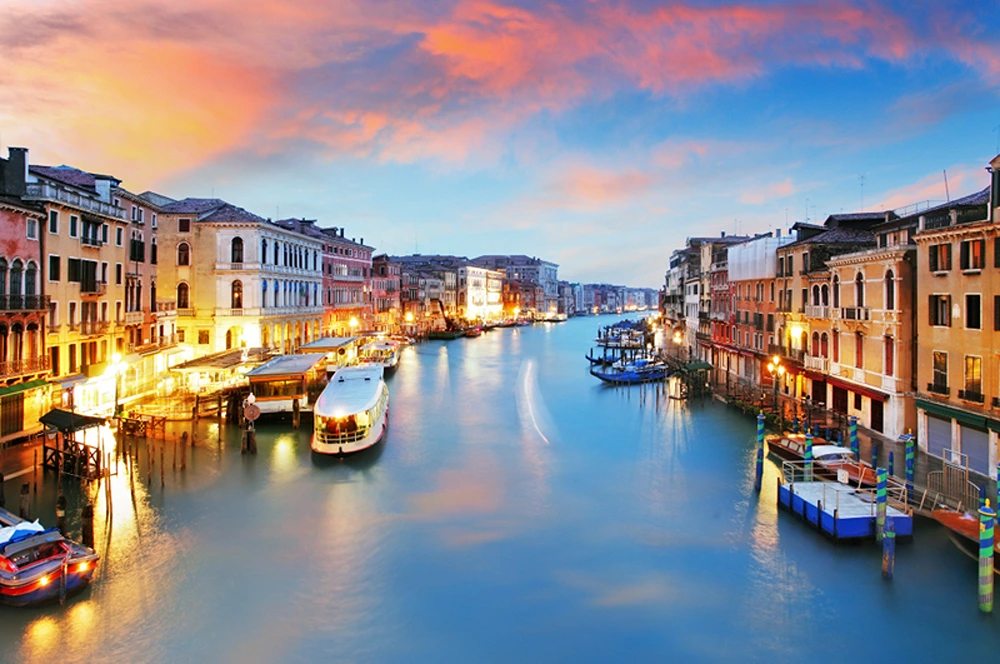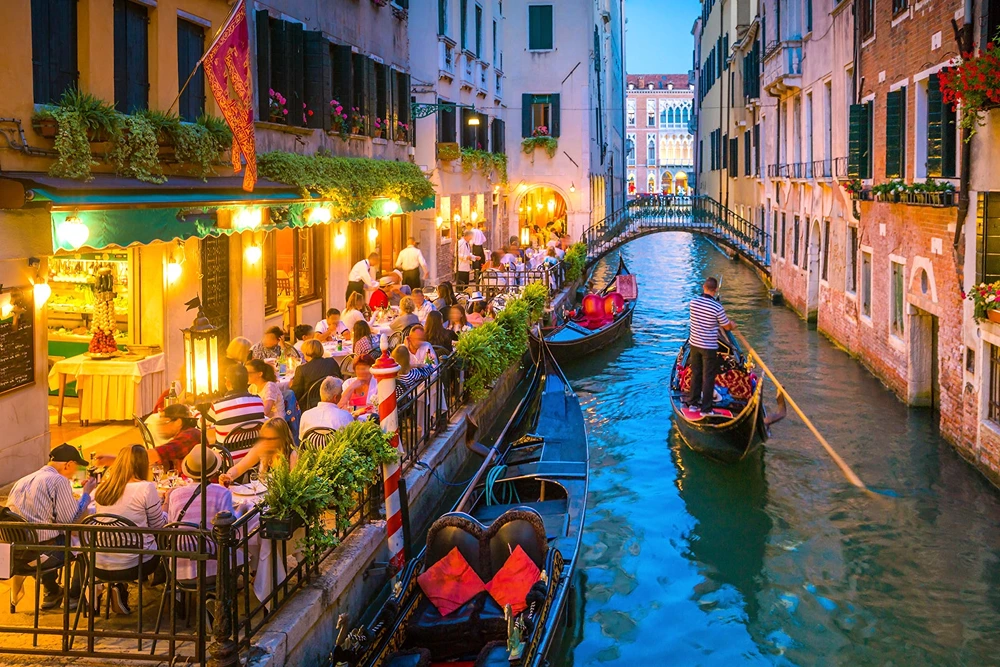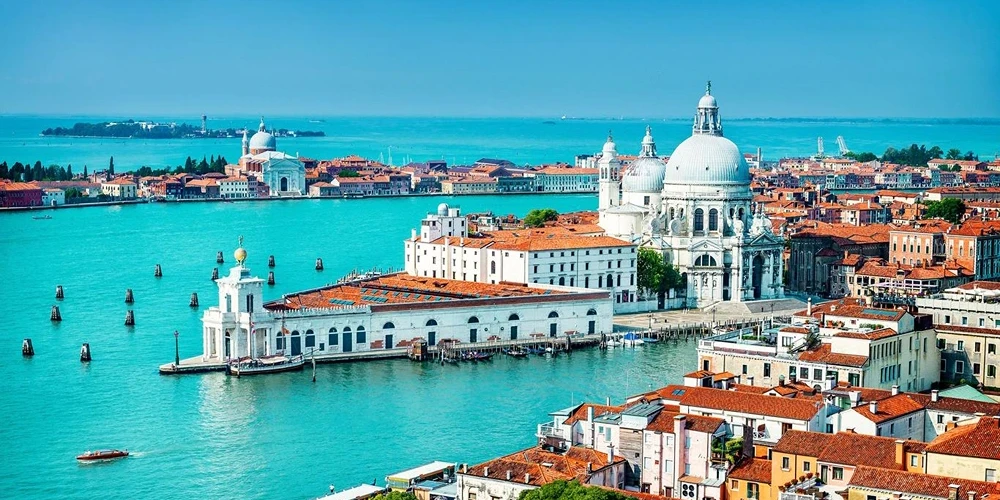Travel Resources
- Find affordable flights to Venice using our flight search tool.
- Ensure peace of mind with comprehensive travel insurance coverage.
- Book tours and experiences with trusted local operators.
- Find the perfect accommodation in Venice for every budget.
- Prepare for your trip with our essential packing checklist.

Some History First
Venice boasts a rich and fascinating history spanning over 1,500 years. Founded in the 5th century as a refuge from barbarian invasions, Venice grew to become a major maritime power by the 10th century. The city-state, known as the Most Serene Republic of Venice, dominated trade between Europe and the Byzantine Empire, later expanding its influence across the Mediterranean. Venice’s strategic location and naval prowess led to immense wealth, funding the construction of its magnificent palaces and churches. During the Renaissance, Venice became a center of art and culture, home to renowned painters like Titian and Tintoretto. The city’s unique architecture, blending Byzantine, Gothic, and Renaissance styles, reflects its diverse historical influences.
Venice Today
Today, Venice continues to enchant visitors with its timeless beauty and unique way of life. Despite facing challenges such as overtourism and rising sea levels, Venice remains a vibrant city that seamlessly blends its rich history with modern life. The city is home to world-class museums, thriving artisan traditions, and a bustling cultural scene. Venice hosts international events like the Venice Biennale and the Venice Film Festival, attracting artists and celebrities from around the globe. While tourism plays a significant role in its economy, efforts are being made to promote sustainable tourism and preserve the city’s delicate ecosystem.
Is Venice Safe?
Venice is generally considered a safe city for tourists, with low rates of violent crime. The main concerns for visitors are petty theft and pickpocketing, particularly in crowded tourist areas and on public transportation. It’s advisable to keep your belongings close and be aware of your surroundings, especially in busy spots like St. Mark’s Square and on vaporetti (water buses). Venice’s unique layout, with its maze of narrow streets and canals, can sometimes be disorienting for visitors. However, this contributes to the city’s charm and safety, as it’s difficult for criminals to make quick getaways.
Where is Venice?
Venice is located in northeastern Italy, in the shallow Venetian Lagoon, an enclosed bay that lies between the Po and Piave Rivers and the Adriatic Sea. The city is the capital of the Veneto region and is situated about 4 kilometers (2.5 miles) from the mainland and 2 kilometers (1.2 miles) from the Adriatic Sea. Venice is composed of 118 small islands separated by canals and connected by over 400 bridges. The city’s unique geography has played a crucial role in its history, defense, and development as a maritime power.
Latest Articles
From The Area
Nothing found.
What is the Best Time to Visit Venice?
The best time to visit Venice depends on your preferences for weather, crowds, and events. Spring (April to June) and fall (September to October) are generally considered the ideal seasons to visit Venice. During these months, temperatures are mild, ranging from 15°C to 25°C (59°F to 77°F), and tourist crowds are more manageable. Summer (July to August) brings hot temperatures and the largest influx of tourists, resulting in higher prices and longer queues at attractions. Winter (November to February) offers a quieter Venice with fewer tourists, lower prices, and the chance to experience the magical Carnival festivities in February. However, be prepared for potential acqua alta (high water) events during this season.
How to Get to Venice & Around
Venice is well-connected and offers unique transportation options:
- By Air: Fly into Venice Marco Polo Airport (VCE) or Treviso Airport (TSF) for budget airlines.
- By Train: Venice’s Santa Lucia train station connects the city to major Italian and European destinations.
- Water Transportation: Vaporetti (water buses) are the main public transport. Water taxis offer faster, more expensive options.
- Walking: Venice is a pedestrian city, with many areas only accessible on foot.
- Gondolas: While primarily a tourist attraction, gondolas offer a romantic way to explore the canals.
Remember that there are no cars, bicycles, or scooters in Venice’s historic center. The city’s unique layout means that water and foot transportation are your only options for getting around.
Things to Do in Venice
Venice offers a wealth of attractions and experiences:
- Mark’s Basilica: Visit this stunning example of Byzantine architecture.
- Doge’s Palace: Explore the former residence of Venice’s rulers.
- Grand Canal: Take a vaporetto ride along Venice’s main waterway.
- Rialto Bridge: See the oldest bridge spanning the Grand Canal.
- Peggy Guggenheim Collection: Admire modern art in a palace on the Grand Canal.
- Murano and Burano: Visit these nearby islands famous for glassmaking and lace.
- Venetian Ghetto: Explore the historic Jewish quarter.
- Libreria Acqua Alta: Browse this unique bookstore with books stored in bathtubs and gondolas.
Book skip-the-line tickets for popular attractions to save time, especially during peak season.
Where To Stay In Venice
Venice offers a range of accommodation options to suit different budgets and preferences:
- San Marco: Central location near major attractions, but can be crowded and expensive.
- Dorsoduro: Quieter area with a local feel, home to many museums and churches.
- Cannaregio: Authentic neighborhood with good value accommodations.
- Castello: Residential area with a mix of quiet streets and busy tourist spots.
- Giudecca: Separate island offering peace and stunning views of Venice.
Book well in advance, especially during peak season and major events like Carnival.

What To Eat In Venice
Venetian cuisine is distinct from other Italian regions, with seafood and rice featuring prominently:
- Cicchetti: Venetian tapas, small snacks typically eaten with wine.
- Risotto al nero di seppia: Risotto with cuttlefish ink.
- Sarde in saor: Sweet and sour sardines with onions, raisins, and pine nuts.
- Baccalà mantecato: Creamed dried cod, often served on polenta.
- Fritto misto: Mixed fried seafood.
- Tiramisu: The famous coffee-flavored dessert originated in the Veneto region.
- Spritz: Popular aperitif made with Prosecco, Aperol or Campari, and soda water.
Try local specialties at bacari (traditional Venetian wine bars) for an authentic experience.
Entry & Exit Requirements
Entry requirements for Venice (Italy) are the same as for the rest of the country:
- EU citizens: Can enter with a valid ID card or passport.
- Non-EU citizens: Generally need a valid passport and may require a Schengen visa.
- Passport validity: Should be valid for at least six months beyond your planned stay.
- Schengen Area: Italy is part of the Schengen Area. Visitors from many countries can stay for up to 90 days within a 180-day period without a visa.
- Tourist tax: Venice charges a tourist tax for overnight stays, usually collected by your accommodation.
Always check the most up-to-date information before traveling, as requirements can change.
What To Pack For Your Trip
When packing for Venice, consider the city’s unique environment and potential weather conditions:
- Comfortable walking shoes: Venice involves a lot of walking, often on uneven surfaces.
- Waterproof shoes: Useful for potential acqua alta (high water) events.
- Light, breathable clothing: For warm summer days.
- Layers: Weather can be changeable, especially in spring and fall.
- Modest attire: For visiting churches and religious sites.
- Insect repellent: Mosquitoes can be an issue, especially near canals.
- Reusable water bottle: Venice has many fountains with drinkable water.
- Power bank: Useful for long days of sightseeing and photography.
Remember to pack light, as you’ll need to carry your luggage through Venice’s streets and over bridges.
FAQs
The official currency of Italy is the Euro (EUR).
While Italian is the official language, many locals in tourist areas speak English. Learning basic Italian phrases can enhance your experience.
Yes, major credit cards are widely accepted in most establishments in Venice.
Swimming in the canals of Venice is prohibited for health and safety reasons.


